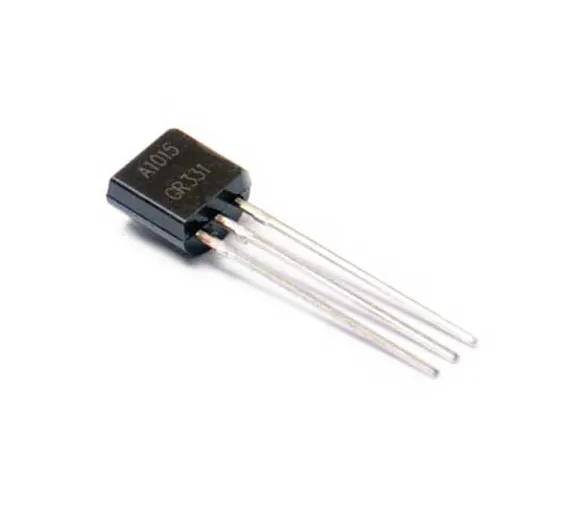
SKU: DBS111,TMD500,Th100,KRT
This is generap purpose audio frequency A1015 PNP Transistor.
Pin Configuration
|
Pin No. |
Pin Name |
Description |
|
1. |
E |
Emitter |
|
2. |
C |
Collector |
|
3. |
B |
Base |
Features and Technical Specifications
- Type: p-n-p
- Power Dissipation: 0.4watts
- High voltage and High current: Vceo = 50v and Ic = 150mA
- Low Noise: 1dB
- Case Material: molded plastic
- Collector power dissipation: 400mW
- DC current gain: 400
- Collector Emitter and Collector Base breakdown voltage: 50Vdc
- Base Emitter Saturation Voltage: 1.1Vdc
- Collector Emitter Saturation Voltage: 0.3Vdc
- Base Emitter voltage: 1.45Vdc
- Complementary to 2SC1815
- Operating Temperature and Storage Temperature: -55? to +150?
Where to Use A1015 PNP Transistors?
The main use of 2SA1015 is for audio frequency amplifier applications. It can also be used for the switching purpose just like other PNP transistors. When use as an Audio frequency general purpose amplifier, can be operated in the active region. This transistor is further divided into four groups according to the DC current gain, O, Y, G, and L and has 140, 240, 400 and 700 hfe DC current gain respectively.
|
Group |
DC current gain (hfe) |
|
O |
140 |
|
Y |
240 |
|
G |
400 |
|
L |
700 |
Amplification factor usually determined in term of power, for calculating the current gain we use the formula:
Gain (hfe) = IC / IB
Where, IC is the collector current and IB is the base current of the circuit.
How to Use A1015 Transistor?
In the below circuit of LED flasher using 2SA1015, capacitor C1 and R1 used as frequency generator to Q1 transistor which is used as switch for Q2. And, Q2 is used for increasing the current. From capacitor C1 through R2 and LED, Q1 will work until the voltage drop increases across C1. As a result, Q2 starts conducting, and a current flows through LED and it turns ON.
While C1 discharged through R1 to a period of time, when C1 discharge out there would be no pressure to bias the base terminal of the Q1. Hence, the Q1 stop working which also stop Q2 to work. Therefore, LED turn OFF and C1 will start again and this cycle continues. And, the turning ON and OFF of LED seems as a flasher.
Applications
- Switching
- Driver stage amplifier action
- AF amplifier
- Can be used Darlington pair
- Used in making led flasher



